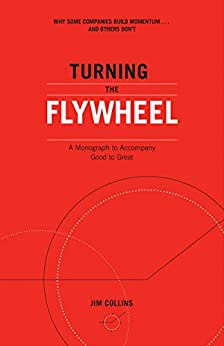More on this book
Community
Kindle Notes & Highlights
by
Jim Collins
Read between
April 18 - April 18, 2020
From its inception, Bezos had infused Amazon with an obsession to create ever more value for ever more customers.
Maurizio Adamo liked this
Lower prices led to more customer visits. More customers increased the volume of sales and attracted more commission-paying third-party sellers to the site.
Over time, Amazon would renew and extend the flywheel far beyond a simple e-commerce website and enhance the flywheel with new technology accelerators such as artificial intelligence and machine learning.
As Stanford Graduate School of Business strategy professor Robert Burgelman once observed to a classroom full of students in 1982 (of which I was one), the greatest danger in business and life lies not in outright failure but in achieving success without understanding why you were successful in the first place.
One of the biggest, and most common, strategic mistakes lies in failing to aggressively and persistently make the most of victories.
Design new chips that customers crave; price high before competition catches up; drive down unit costs as volume increases (due to economies of scale); harvest high profits even as competition drives down prices; and reinvest those profits into R&D to design the next generation of chips.
There’s a hierarchy of social influence for athletic gear.
Invent great products; get elite athletes to use them; inspire Weekend Warriors to mimic their heroes; attract
mainstream customers; and build brand power as more and more athletes use the products.
A flywheel need not be entirely unique. Two successful organizations can have similar flywheels. What matters most is how well you understand your flywheel and how well you execute on each component over a long series of iterations.
To be clear, the big winners in corporate history consistently surpassed a threshold level of innovation required to compete in their industries. But what truly set the big winners apart was their ability to turn initial success into a sustained flywheel, even if they started out behind the pioneers.9
The flywheel, when properly conceived and executed, creates both continuity and change. On the one hand, you need to stay with a flywheel long enough to get its full compounding effect. On the other hand, to keep the flywheel spinning, you need to continually renew, and improve each and every component.
When it comes to the flywheel, you need to fully embrace the Genius of the AND, sustain the flywheel AND renew the flywheel.
There are two possible explanations for a stalled or stuck flywheel. Possible explanation #1: The underlying flywheel is just fine, but you’re failing to innovate and execute brilliantly on every single component; the flywheel needs to be reinvigorated. Possible explanation #2: The underlying flywheel no longer fits reality and must be changed in some significant way. It’s imperative that you make the right diagnosis.
True discipline requires the independence of mind to reject pressures to conform in ways incompatible with values, performance standards, and long-term aspirations.
When you have disciplined people, you don’t need hierarchy. When you have disciplined thought, you don’t need bureaucracy. When you have disciplined action, you don’t need excessive controls. When you combine a culture of discipline with an ethic of entrepreneurship, you create a powerful mixture that correlates with great performance.
Stage 1: Disciplined People Stage 2: Disciplined Thought Stage 3: Disciplined Action Stage 4: Building to Last
Level 5 leaders can come in many personality packages, they’re often self-effacing, quiet, reserved, and even shy.
Every good-to-great transition in our research began with a Level 5 leader who motivated people more with inspired standards than inspiring personality.
Those who lead organizations from good to great first get the right people on the bus (and the wrong people off the bus) and then figure out where to drive the bus. They always think first about “who” and then about “what.”
your best “strategy” is to have a busload of people who can adapt and perform brilliantly no matter what comes next.
Great vision without great people is irrelevant.
The Hedgehog Concept is a simple, crystalline concept that flows from deep understanding about the intersection of the following three circles: (1) what you’re deeply passionate about, (2) what you can be the best in the world at, and (3) what drives your economic or resource engine.
Enduring great organizations embody a dynamic duality. On the one hand,
they have a set of timeless core values and core purpose (reason for being) that remain constant over time. On the other hand, they have a relentless drive for progress—change, improvement, innovation, and renewal. Great organizations understand the difference between their core values and purpose (which almost never change), and operating strategies and cultural practices (which endlessly adapt to a changing world).
superior results, distinctive impact, and lasting endurance.
Big does not equal great, and great does not equal big.
A truly great organization prospers over a long period of time, beyond any great idea, market opportunity, technology cycle, or well-funded program.
if your organization cannot be great without you, then it is not yet a truly great organization.
Greatness is an inherently dynamic process, not an end point. The moment you think of yourself as great, your slide toward mediocrity will have already begun.


